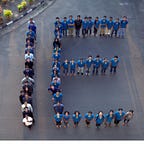The Time We Heard Black Holes Collide
Around 1.3 billion years ago, in some distant corner (whether the universe has corners is debatable, but just bear with me) of the universe 2 black holes apparently collided.
Why did I use the word ‘apparently’?
Well, how could we have confirmed or even known that two black holes did collide? I mean, doesn’t it seem like something impossible to actually verify? Even Albert Einstein wasn’t sure that we could ever detect such an event happening. But, against all odds, on the 14th of September 2015 this exact, incomprehensible-to-many, event was detected.
This incredible feat was made possible using LIGO — Laser Interferometer Gravitational-Wave Observatory pioneered by physicists Rainer Weiss, Kip Thorne and Barry Barish, who for their work have been awarded the Nobel Prize in Physics for the year 2017.
In 1984, Weiss and Thorne came up with the plans for LIGO and it was Barish who later guided the construction of the twin LIGO observatories. Weiss will receive one half of the 900,000 Swedish kroner prize, and Thorne and Barish the other half.
The two black holes on colliding will definitely not have produced any sound waves that could’ve been detected by us. So how was it done?
LIGO detects gravitational waves.
In his Theory of General Relativity, Albert Einstein explains that gravity is something that comes about when mass and energy warp the fabric of space-time, causing freely falling objects to follow curved trajectories. A year later he predicted that a twirling barbell-shaped arrangement of mass — such as two spiralling black holes — should radiate ripples in space that would zip through the universe at light-speed.
LIGO actually consists of 2 massive science experiments: One in Louisiana and the other in Washington state, both consisting of L shaped tubes, each arm being 2.5 miles long. These devices are called interferometers. During the experiments, a laser beam is split equally between the two arms.
“At the end of each arm is a mirror, which reflects the laser back to the starting point. What LIGO is looking for is evidence that gravitational waves are distorting space-time enough that one of the arms becomes temporarily longer than the other.” -www.vox.com
Two black holes colliding would result in its surroundings being expanded and contracted wildly, but by the time it reaches the earth the ‘ripples’ would’ve grown faint or damped; so much so that one of the waves that LIGO heard was just 0.7 attometres tall (1 attometre = 10^-18 metres). It’s amazing that we can detect something so miniscule but which also has such far reaching implications.
By listening in on these loud waves, the scientists are able to reconstruct the cataclysmic events that created them. Other details such as the mass of the black holes and how far away they are have also been determined from just the data that we have till now from LIGO.
The discovery of gravitational waves has flung open the doors to the completely new field of ‘Gravitational Wave Astronomy’
So what can the era of Gravitational Wave Astronomy accomplish?
- Seeing Further Back in Time: We could potentially be able to listen in on the gravitational waves from the early universe, maybe even The Big Bang.
- Discover New Neutron Stars
- Find the Source of Dark Matter
- Or maybe, be completely surprised by something we didn’t expect at all.
We don’t know what mysteries hide in the abyss that envelopes us. With the help of LIGO and all the researchers who have contributed to its development including Weiss, Thorne and Barish, we have just witnessed the dawn of ‘Gravitational Wave Astronomy’.
It may just go on to reveal an entirely unfamiliar facet of the Universe.
- Varsha Mavath
Sources:
· ‘Gravitational waves, explained’- vox.com
· Science|Business
· ‘Ripples in Space’ — ScienceMag
· The Royal Swedish Academy of Sciences- Press Release- Nobel Prize in Physics 2017
